The Hidden Costs of Your Aging Washer
Your current "old faithful" washer/disinfector in sterile processing has worked great for years, but is it costing you more and more each year?
Most washers are designed to perform at optimal levels for 8-10 years, with many sterile processing departments (SPDs) keeping the same washer/disinfector for more than 10 years. Some facilities, based on usage, might keep "old faithful" going based on budget constraints. Although this can work for some, it's important to consider all costs. It's also important to ask - is your equipment meeting your department's current needs? While the washer may be "paid for," what does it truly cost you today?
In this article, we will look at the costs, both obvious and hidden, and see why you might need to consider a replacement and, if so, how you can plan for a new washer/disinfector.
Tangible Costs of Your Washer/Disinfector
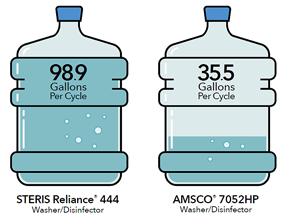
It is no secret that older equipment can cost more to operate and maintain, much like cars and even appliances in our house. The obvious costs are maintenance and utilities.
While you may think you are saving money by leveraging your current solution, these costs can significantly add up over time. You may not realize it but older washers can use nearly three times the water of newer washers.
Compare STERIS Reliance® 444 Washer/Disinfector that uses 98.9 gallons per cycle with the new AMSCO® 7052HP Washer/Disinfector that uses only 35.5 gallons per cycle. How many gallons is that per year? This depends on how many cycles your facility runs per day, but assuming just 10 cycles per day (with 260 working days per year) – you could be using over 165,000 more gallons per year compared to a newer washer/disinfector.
Next, consider your consumable costs. Some older washers are not compatible with modern ultra-concentrated chemistries or may require additional external dosing systems to deliver these chemistries.
Newer models can use 10x concentrate chemistries which means fewer containers, less waste to dispose of, fewer purchase orders, and reduced shipping costs. All tangible, immediate realized savings.
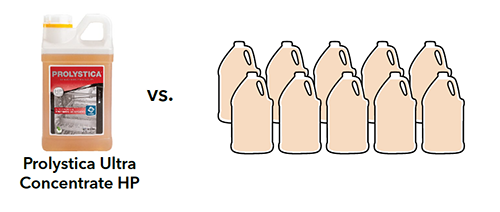
The Hidden Costs of Your Washer/Disinfector
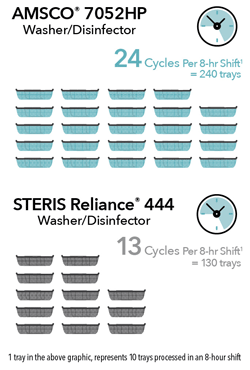
Utility and consumable inefficiencies are the obvious costs of an old washer/disinfector. What about significant costs that aren't as apparent?
Department productivity is the most significant hidden cost of operating an old washer/disinfector. Maximum throughput is key to keeping your sterile processing department running efficiently and supporting growing caseloads into the future. Productivity can be measured by the throughput delivered from your sterile processing solutions.
First, consider cycle time and trays per cycle. Modern washers have cycle times up to 45% faster than older models. For example, the new AMSCO® 7052HP Washer/Disinfector can run 24 cycles in an 8-hour shift, washing 240 trays per shift! An older Reliance 444 Washer/Disinfector, however can only run 13 cycles in that same time, processing up to 130 trays per shift1.
Here's what a STERIS Customer had to say when they upgraded their older washer:
“Our STERIS 7053 HP Washer/Disinfector with RAS cycle has been a game changer. We averaged 390 wash cycles per month with our smaller Synergy washer. It could hold 6, single level trays. Our total knee and total hip trays for one case could be 9-11 trays. Our big orthopedic days could average 3-7 cases. As you can well imagine, by the end of first shift, we had quite of a backlog of instruments.
Now, with the same demand, we average 365 wash cycles per month with the STERIS 7053HP Washer. It holds 9 full size single level trays. We are now able to keep instruments flowing throughout the day and turnover is so much faster.”
- Toni Cibak, CST, CRCST - Manager Sterile Processing
Beyond productivity, older washers/disinfectors, similar to older appliances, can break down and need to be serviced more often. This creates a greater need for routine maintenance and could increase downtime, a challenge for any busy Sterile Processing Department.
The final hidden cost of your old washer/disinfector requires looking toward the future. With the growth of complex procedures, like orthopedic and robotic assisted surgeries, technicians are spending considerable time manually cleaning intricate devices that are not compatible with your current washer/disinfectors' cycles. This need is likely to increase as procedure volumes grow.
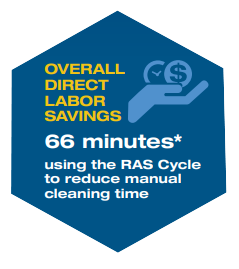 *per set of 4 instruments
*per set of 4 instrumentsThe new RAS (Robotic Assisted Surgery) Cycle on the AMSCO 7052HP & 7053HP Washer/Disinfectors, RAS 12 Racks, and Prolystica® Ultra Concentrate HP Enzymatic and Neutral Chemistries are specifically designed to automate the cleaning and disinfection process of select da Vinci instruments2. Only the AMSCO 7052HP or 7053HP can improve department productivity with up to a 25% reduction in manual cleaning time per set of 4 da Vinci instruments.
Not only are the instruments washed more consistently, but technician time can be used to support other needs in the department.
Overall, the numbers don't lie. Compare cycle times, productivity, utility costs, and total cost of operations for older vs. a newer washer:
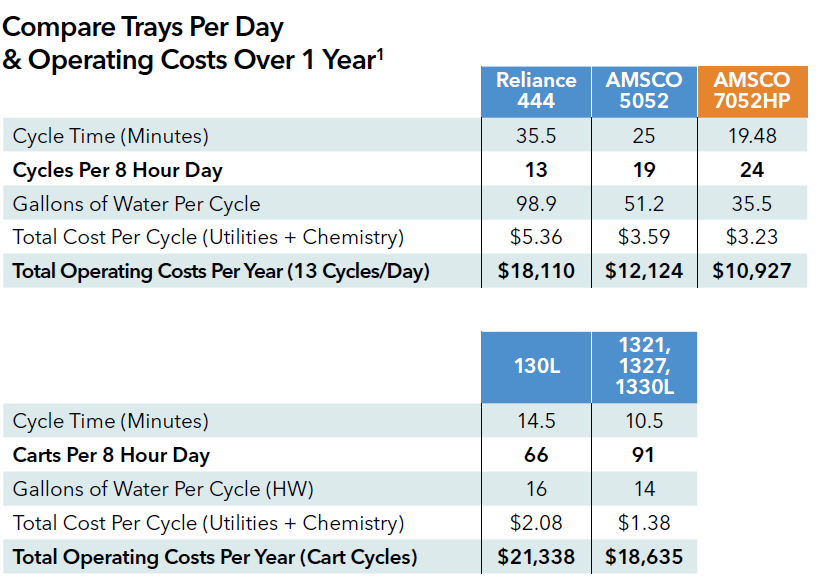
Compliance and Audit Readiness
Look at the tangible costs and hidden costs. The savings are apparent. What also has to be taken into consideration are compliance and audit readiness.
With the growing use of technology in your SPD, some of today's modern washer/disinfectors integrate with surgical instrument tracking systems, monitor water temperature/pump pressure, chemistry dosing, and more: no more 3-ring binders, cycle tapes, or hand-written reports.
The potential for error in hand-written reporting and monitoring is greatly diminished. Built-in tracking and tracing also can help reduce the backlog of instruments, keeping your facility running smoothly, allowing your department to operate at the highest efficiency and maximum audit readiness.
Are You Ready to Upgrade?
"Old faithful," while it still works, may be holding your sterile processing department back. When evaluating your current washer/disinfectors' productivity, look into the costs you can see, hidden costs, and the total cost of ownership.
Explore STERIS Washer/Disinfectors
Article References
1 Single Chamber Washer/Disinfector Assumptions: 13 cycles per day, 260 working days. Steam Heated, 208V Electric, Vented, No Condensate Return, PUC Chemistries (Enzyme + Neutral), 7052HP: Acu Rinse & Acu-Wash, Average utility rates in US, PUC Enzyme - $1.3440 per ounce, PUC Neutral - $.8450 per ounce, Prolystica lubricant - $.949 per ounce. Cart Washer/Disinfector Assumptions: 260 working days, 2 carts per cycle, 2 fills per day, Steam Heated, 208V Electric, Vented, No Condensate Return, PUC Chemistries (Neutral), Average utility rates in US, PUC Neutral - $.7855 per ounce, Dri 'N Shine - $.1016 per ounce, Drain discharge cooldown
2 The RAS Racks are used in the RAS Cycle of the AMSCO 7052HP Single-Chamber Washer/Disinfector and the AMSCO 7053HP Single-Chamber Washer/Disinfector for the effective cleaning, rinsing, intermediate level disinfection and drying of reusable da Vinci® X/Xi and S/Si EndoWrist® instruments.
*da Vinci®, EndoWrist® are registered trademarks of Intuitive Surgical
 United States
United States
 Canada (EN)
Canada (EN) Canada (FR)
Canada (FR) Deutschland
Deutschland Italia
Italia United Kingdom
United Kingdom Australia
Australia New Zealand
New Zealand Singapore
Singapore Brasil
Brasil México
México






